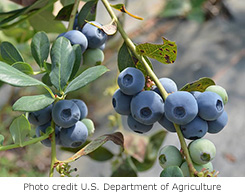 It’s summertime in the northern hemisphere, and food stores and farmer’s markets are offering an abundance of locally grown produce, including seasonal fruits and berries. From June through September, a colorful palette of berries invites us to indulge our taste buds and reap fabulous health benefits! The Cayce readings recommend berries for their cleansing properties, as well as for their nerve-building qualities and their nutritional contribution of iron, phosphorus, and silicon. Just a few readings mention specific types of berries, such as blackberries, gooseberries, or raspberries. Only a single reading highlights the blueberry, suggesting to “...especially use the garden blueberry.” (3118-1) However, this reading, given for a 56-year-old woman suffering from multiple sclerosis, includes a significant promise regarding the blueberry’s nutritional potential: “This is a property which someone, some day, will use in its proper place!” In the 21st century, we have seen this promise fulfilled as the blueberry is one of the most intensely researched and medicinally valued foods of our time.
It’s summertime in the northern hemisphere, and food stores and farmer’s markets are offering an abundance of locally grown produce, including seasonal fruits and berries. From June through September, a colorful palette of berries invites us to indulge our taste buds and reap fabulous health benefits! The Cayce readings recommend berries for their cleansing properties, as well as for their nerve-building qualities and their nutritional contribution of iron, phosphorus, and silicon. Just a few readings mention specific types of berries, such as blackberries, gooseberries, or raspberries. Only a single reading highlights the blueberry, suggesting to “...especially use the garden blueberry.” (3118-1) However, this reading, given for a 56-year-old woman suffering from multiple sclerosis, includes a significant promise regarding the blueberry’s nutritional potential: “This is a property which someone, some day, will use in its proper place!” In the 21st century, we have seen this promise fulfilled as the blueberry is one of the most intensely researched and medicinally valued foods of our time.
Blueberries pack a powerful nutritional punch. They provide the minerals calcium, magnesium, iron, potassium, phosphorus, and zinc, along with small amounts of vitamins A, B, and C. Blueberries also contain dietary fiber, important for digestive health. They are exceptionally high in manganese, an essential trace mineral that plays an important role in bone formation and helps the body metabolize protein, carbohydrates, and fat. Blueberries are also packed with antioxidants, powerful phytochemicals that assist the body in neutralizing free radicals, which have been associated with various degenerative conditions, including heart disease, cancer, and mental decline. The bioflavonoid antioxidants anthocyanin and proanthocyanin, which provide some of the pigments that lend blueberries their deep purple-blue color, have been shown to offer protection against inflammation. Chronic inflammation at the cellular level has been linked to several degenerative and age-related diseases.
Cardiovascular and metabolic health benefits
In recent years, researchers have identified numerous health benefits linked to the consumption of blueberries. In a 2010 study conducted at Pennington Biomedical Research Centre in Baton Rouge, Louisiana, obese study subjects who had a family history of diabetes and who were considered “prediabetic” were shown to have improved insulin resistance and a reduced risk of developing Type 2 diabetes as a result of consuming a blueberry-rich smoothie twice daily over a 42-day period. Previously, an animal study at University of Michigan Cardiovascular Center had demonstrated that a blueberry-rich diet significantly reduced the risks of cardiovascular disease and metabolic syndrome, which relates to a group of health conditions that include excessive abdominal fat, high blood pressure, and elevated blood sugar. The Michigan study determined that blueberry intake positively affected genes related to fat-burning and -storage.
Memory booster
Recent research conducted at the University of Cincinnati showed that drinking two cups of blueberry juice each day for 12 weeks improved memory scores in elderly study subjects. Averaging 78 years of age, participants registered no weight gain over the course of the study. The blueberry's high content of anthocyanins, which have been associated with increased neuronal signaling in the brain, may partially explain the surprising results of this memory study. Previous research, conducted with animals, had also linked blueberry consumption to memory improvement. Several years earlier, a study at the USDA Human Nutrition Research Center on Aging suggested that a blueberry-rich diet may improve motor skills and reverse age-related short-term memory loss.
Additional research has confirmed the blueberry's role in supporting cardiovascular health, reducing undesirable LDL cholesterol levels, and protecting the heart muscle and brain against damage. A cousin of the European bilberry, which has been shown to improve night vision and prevent tired eyes, the blueberry has also been credited with benefiting eye health and reducing eye fatigue.
 Cultivated vs. wild
Cultivated vs. wild
The large, juicy, plump-looking blueberries sold in supermarkets are typically the cultivated kind. Wild blueberries tend to be smaller in size, but higher in disease-fighting antioxidants. Both offer the opportunity of combining culinary pleasure with medicinal properties. Enjoy the delicious taste of blueberries on their own or combined with other fruits and berries, or sprinkle them over your morning cereal. Add blueberries to pancakes, muffins, or crisps. Put them in your blender with other berries and fruits, then add yogurt, milk, or almond milk for a delicious smoothie.
North America's blueberry season begins in Florida in mid-May, then moves farther north and concludes in Canada by September, although controlled-atmosphere storage keeps the market supplied with North American berries for a few weeks longer. Freeze the fresh berries for use during winter, or purchase them frozen for year-round enjoyment of some of the best disease protection nutrition can provide!
Originally published in Venture Inward magazine.
Copyright © Simone Gabbay